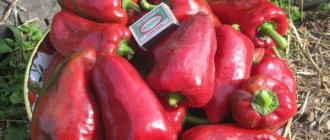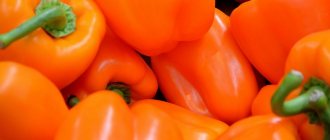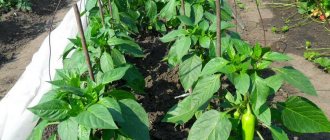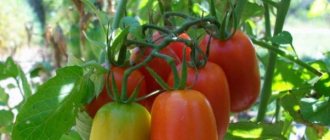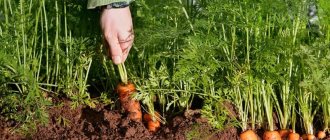The bright multi-colored fruits of bell peppers during the harvest period are a real decoration of any summer cottage. Healthy paprika looks appetizing on the table in salads, hot dishes, and canned food. Only laudatory reviews are written about pepper as a storehouse of vitamins.
The Tolstyachok sweet pepper variety fully corresponds to its name - the bright red fruits have thick and juicy walls. Both experienced and novice gardeners reap a significant harvest by following simple rules for growing and caring for crops.
Fatty - what kind of pepper is this?
The Tolstyachok variety is a hybrid that is the result of combining other varieties . As befits a hybrid, Fatty has a strong immunity to diseases, is unpretentious in care and tolerates sudden temperature changes well.
Description of the variety
- The variety is mid-season, the harvest is harvested 115 days after planting.
- They are grown both in greenhouses and in open ground.
- The bushes are small, about 45-55 cm in height.
- The plant is semi-spreading and has a strong stem.
- The leaves are slightly wavy, bright green, medium in size.
For the fastest and healthiest development, gardeners recommend forming a bush . Otherwise, caring for Tolstyachok sweet peppers does not require special skills.
Fruit characteristics and yield
The pepper has a slightly rounded, prism-shaped shape. The average weight of one fruit is about 150 g, in favorable climatic conditions it can reach 200 g . Length about 10 cm, diameter 7 cm.
The surface is smooth and glossy, bright red in color. The pulp is thick and has a pronounced sweet taste. Thanks to its dense peel, the Tolstyachok variety is perfectly stored and transported. Yield indicators are stable, from 1 sq. m, gardeners collect about 4 kg of healthy vegetables.
Interesting! Central America is considered to be the birthplace of pepper. It was in its areas that archaeologists found the first mentions of the vegetable. People have been using peppers as food since 6,000 BC. Later, breeders from Bulgaria managed to develop sweet varieties, which received the well-known name “Bulgarian”.
Characteristics and features
Inexperienced gardeners need advice on what kind of pepper Fatty is, the characteristics and description of this variety of vegetable are given below.
The fruits of the crop ripen 105-115 days after the appearance of the first shoots. When technically mature they are green; when biologically mature they become bright red. With proper care, you can get a good amount of harvest from 1 square - about 5 kg.
Attention! According to gardeners, this hybrid behaves well in almost any type of soil and is not inferior in quality to varietal plants.
Preparation for cultivation
Growing sweet peppers is an easy process. Prepared soil will be the key to a good harvest . Future beds must be clean, disinfected and filled with plant nutrients and elements.
In the fall, they are dug up on the handle of a shovel, removing all debris and weeds. Then ash and compost are scattered to reduce the acidity of the soil, make it more useful, and destroy pathogenic elements.
In the spring, the beds are dug up again and Nitrofoska fertilizer is applied . To make the soil looser and lighter, it is sprinkled with sawdust or river sand, which serve as an excellent natural leavening agent. To disinfect the beds, water them with a manganese solution. This will protect the plants from infectious and viral diseases.
Seed preparation:
- Place in the oven for 3 hours at 40°C.
- Germinate the material by placing it in a damp cloth bag and storing it in a warm place.
- After 5 days, the seeds will give the first sprouts, after which hardening is carried out: put the seed material in the freezer for 1 hour. In the future, carry out the procedure for another 4-5 days, each time increasing the time the seeds are in the freezer by 15-20 minutes. Hardening helps plants quickly adapt to the climatic conditions of the growing region.
It can be useful:
Why peppers don't bloom in a greenhouse
Measures to combat fusarium wilt of pepper
How to freeze peppers for the winter for stuffing
Popular varieties and hybrids of thick-walled peppers for growing without a greenhouse
In total, there are more than 1000 varieties and hybrids of sweet peppers. However, not everyone has received real popular recognition. Only the most delicious, productive and unpretentious ones have gained universal love and respect. Below are some of them, the distinctive feature of which is a thick wall and the ability to grow in open ground.
It is one of the most popular varieties of sweet peppers, and there are many reasons for this. It is resistant to many diseases, ripens early and has good yield. The fruits are characterized by a pleasant aroma, juiciness and are suitable for any purpose. Each of them has an average weight of about 150 g and a wall thickness of 0.9 cm. Many people like their spherical shape.
Pepper Kolobok
This name was not given to it in vain, since the weight of one fruit can reach 300-400 and even 600 g. The walls are fleshy, up to 1 cm thick; There is sweetness in the taste. The red giant belongs to the mid-season varieties, and the height of the bush reaches one meter. The yield is good - about a dozen peppers are collected from the bush. This is one of the most prominent representatives of its family.
Red giant
This variety of pepper bush is suitable for growing both in open ground and in a greenhouse. It reaches a meter in height, but is strong enough not to need tying. You can collect up to 15 peppers from one plant. California miracle belongs to the mid-season varieties, has an excellent aroma and a wall thickness of about 5 cm. California miracle
This variety belongs to the mid-season group and is suitable for growing in open and closed ground. The plant reaches a height of about 50 cm and needs to be formed into a bush by pruning. The taste of the fruit, which can reach a weight of 130 g, is highly rated, the wall thickness is about 1 cm. They tolerate storage and transportation especially well.
Fatty
This sweet pepper may be one of the first on the kitchen table, but its aroma is very delicate and barely noticeable. The sunny color of the fruits, which sometimes weigh half a kilogram, is unusual. It is convenient to grow bugai in open ground, as the bushes grow strong and low. Pepper can be stored well after harvesting without losing its original appearance.
The fruits are distinguished by a dark red color, excellent taste, thin skin, have an average weight of 250 g and a wall thickness of 1 cm. Anastasia is a standard hybrid, so its height is limited to 60-80 cm. In terms of ripening, it is a mid-early sweet pepper.
Anastasia
This sweet pepper with thick walls has the usual red color, but a rather unusual shape, which explains such an interesting name - it is thin and elongated (up to 20 cm in length); average weight - 150 g. It is grown in open ground, in a greenhouse, and under film; it is one of the first to appear on the table. The pulp is juicy, up to 0.8 cm thick. Ox ear has proven to be quite resistant to many diseases and tolerates transportation well.
ox ear
Very tasty thick-walled pepper, with an average weight of 200 g and a wall thickness of up to 0.7 cm. Grown for processing and fresh consumption. Refers to mid-season varieties. Forms a strong compact bush and is not too demanding in care. Well suited for cool summer conditions.
The fruits of this thick-walled sweet pepper (pulp thickness 0.6-0.8 cm) have universal use, have a pronounced aroma, and their weight can reach half a kilogram. The variety is mid-season.
Sun of Italy
The considered thick-walled sweet pepper varieties for open ground are not the limit of the entire range. There are many other varieties of this crop that have thick flesh and are suitable for open ground. However, the varieties listed above are the most in demand, which means it’s best to start with them. Most likely, after this you will no longer want to conduct experiments on your site.
Read also: When to dig up garlic: harvesting and storing garlic
Growing seedlings
Sowing seeds for seedlings is carried out 2 months before planting peppers in open ground . Only healthy seeds are used, small or damaged specimens are removed. Before sowing, be sure to soak the seeds in a solution of the drug “Fitosporin-M” or “Maxim”. They also prepare a container for seedlings; most often, gardeners use plastic cassettes with trays or plastic cups. They are inexpensive and easy to use.
Important! Pay attention to the soil for seedlings. It is better to use disinfected soil from the garden, adding washed sand to it (in a ratio of 6:1). Gardeners also add peat or humus to the composition. If you don’t have the time or desire to prepare the soil yourself, buy ready-made “Universal” soil in the store.
- Pour the prepared mixture into the container, make small holes 1-2 cm deep in it. The distance between the holes is at least 5 cm.
- Place the sprouted seeds in the grooves, sprinkle soil on top and water generously.
- Cover the seedlings with film and place them on the sunniest windowsill.
- Remove the film after the first leaves appear.
- Water the seeds generously with warm filtered water. Next time moisturize in a week. Excess moisture will harm the seedlings.
When growing pepper seedlings on a windowsill, avoid drafts . Water every 5 days at the root to prevent moisture from getting on the leaves. Water should be at room temperature, as cold water increases the risk of developing dangerous microbes.
The Tolstyachok variety loves organic fertilizers , such as a nettle-based solution, wood ash, and liquid mullein. For faster development of sprouts, the growth stimulator “Zircon” is added to the seedlings.
Important! Some gardeners, after 15-20 days from the moment of planting, pick, that is, transplant the seedlings into a larger container. The purpose of picking is to obtain peppers with the largest number of lateral roots, which affect the quality of the harvest. Each gardener decides for himself whether to pick pepper or not. The root system of the plant is vulnerable and can break, which will negatively affect the amount of harvest.
Sowing pepper Tolstyachok for seedlings
Sowing seeds for seedlings is carried out 2-2.5 months before planting peppers in the ground. This period falls in the second half of February and the beginning of March.
It is advisable to treat the seeds before planting in the ground. To do this, use a weak solution of potassium permanganate, into which the seeds are immersed for 20 minutes, then the planting material is thoroughly dried. Next, the seeds are planted in moderately moist soil to a depth of 2.5 cm. The containers are placed in a warm place, covered with polyethylene and left until the first shoots appear.
Planting peppers in open ground
10 days before planting seedlings, the plant is hardened off . To do this, lower the temperature in the room and take the container with the sprouts outside or onto the balcony. Gradually the temperature drops by 17-18 degrees. A week before planting, seedlings are sprayed with a solution of copper sulfate or Bordeaux mixture. These products protect fragile bushes from fungus. When using drugs, take precautions - work with gloves and a respirator.
Within a couple of days, the seedlings are moistened abundantly to make it easier to transplant into the beds in the future . On the day of planting, grooves are made on the prepared soil at a distance of 40-50 cm from each other. Carefully remove the sprouts with a lump of earth and place them on the garden bed. Sprinkle with soil, compacting it at the base of the plant.
PEPPER The most delicious and fastest peppers, which varieties to take for the season.
Pepper varieties for country houses in Belarus
Breeders have developed excellent varieties of thick-walled sweet pepper for Belarus. Summer residents of the Gomel and Brest regions today have the opportunity to grow thick-walled peppers in open ground, reaping a good harvest. In other areas, peppers are best planted under film.
- Among the early varieties, the varieties “Alesya” and “Boogi” have proven themselves to be excellent. The short bushes produce amazingly tasty fruits with a wall thickness of 7–8 mm. You can eat dark green peppers during the period of technical maturity or wait until they are fully ripe and have a bright red color.
- The red and yellow “Cube” produces an excellent harvest on Belarusian soil. The taste of the fruit leaves no one indifferent. The weight of one pepper can reach 250 g. Lecho made from yellow and red varieties has an unusual taste, which is appreciated by gourmets. The harvest can be transported over long distances and stored.
- Thick-walled pepper of the Parnassus variety is a mid-season variety. The cube-shaped or large heart-shaped fruits become yellow-orange in color when ripe. The walls, up to 10 mm thick, are dense, aromatic and have good taste. Suitable for fresh and canned consumption.
- Hybrid “Master” is distinguished by its resistance to disease and temperature changes. When fully ripe, the fruits acquire a rich red color. Cone-shaped peppers are good for stuffing, canning and adding to salads.
- Mid-season varieties “Bogatyr”, “Spartacus”, “Red Knight”, “Golden Rain”, when grown in greenhouses, give a greater yield than in open beds. The taste is good, but the fruit size is smaller than that of early peppers. Excellent for preparing sauces and salads for wrapping.
Caring for sweet peppers
The Tolstyachok variety needs regular watering every 3-5 days . 1 bush requires about 2 liters of water. In dry and hot summers, water the vegetable daily, but make sure not to over-moisten the soil. Excess water leads to the formation of rot and other dangerous diseases.
The appearance of the plant requires attention . If the leaves begin to curl, then the plant needs moisture. Experts recommend watering your bushes early in the morning to avoid sunburn.
The next mandatory stage of care is loosening the beds . It not only improves the flow of oxygen to the roots, but also helps get rid of weeds. It is better to loosen the soil after watering, going 5-10 cm deep. If the soil is too hard and dense, then loosen it more deeply. The procedure is carried out after each watering and rain. Row spacing also needs regular weeding. When the bushes begin to bloom, the stems are sprinkled with loose, slightly damp soil.
Sweet peppers are also regularly fed with mineral complexes or organic fertilizers . The first feeding is organized after 15 days, using potassium-phosphorus compounds or liquid bird droppings. Add 50 g of superphosphate and 10 g of potassium chloride to 10 liters of water. In total, during the ripening period, peppers are fed 3-4 times. The vegetable especially needs nutrition during the period of fruit formation. Plants are fertilized with ash or the Zdraven mineral complex. (on the picture)
Rules of care after planting in the soil
The period after planting is quite important, because in order for the plant to take root and fully realize its productive qualities, it is necessary to create all the necessary conditions.
Watering
For this vegetable, moderate regular watering is recommended; the need for this is determined based on the condition of the top layer of soil: if it has dried out, the procedure can be carried out.
Fertilizer application
Plants planted in the ground are fertilized 3-4 times with a solution of chicken manure in a concentration of 1 part fertilizer to 10 parts water. Alternating it with mineral fertilizers.
A lack of nutrients is indicated by the appearance of the plant:
- the leaf curls and a dried border appears - lack of potassium;
- matte foliage with a grayish tint indicates nitrogen deficiency;
- The plant indicates its need for phosphorus by changing the color of the lower part of the leaf; it turns purple.
We advise you to find out what to feed your peppers during flowering and setting.
Hilling and loosening the soil
This moment should not be missed, because thanks to this the soil is saturated with air and perfectly passes water. Hilling should be done carefully so as not to damage the root system of the plant. For this purpose, the earth is raked to the base. During hilling, weeds should be removed.
There are four stages of the procedure:
- after the second watering, 2 days later, the soil is raked to a height of 6–8 cm;
- during flowering - by 10–12 cm;
- beginning of ovary formation - 14–16 cm;
- Peak fruiting is 6–8 cm.
As for the row spacing, they are loosened; 5 repetitions are enough for the season, adhering to a number of rules:
- before flowering, loosen to a depth of 12 cm;
- during the formation of ovaries - up to 15 cm;
- at the peak of fruiting - up to 25 cm.
Basic rules for forming a bush
Forming a bush allows you to increase the yield and size of the fruit itself. During the growth period, weak side shoots should be removed, as well as long ones should be shortened, getting rid of shaded areas. It is considered mandatory to get rid of all shoots growing below the main fork. Such manipulations are carried out every 10 days, as well as after each harvest.
Video: How to shape peppers
Features of cultivation and possible difficulties
After planting the pepper in open ground, it is covered with burlap or thick polyethylene . This is necessary to protect the pepper from possible frost. Gardeners from regions with unpredictable climatic conditions pay special attention to this. As soon as the warm summer comes into its own, the protective structures can be removed.
Don't forget about bush formation . After the formation of 10-12 leaves, the side shoots are removed. Only 2-3 shoots are left, which grow from the main bud.
Next, they observe the plant, and as soon as new shoots appear, leave one of the largest ones, and carefully cut off the rest . Formation is necessary to ensure that the fruits are large and juicy.
Often the ovaries and flowers fall off . The reason for this may be too low or high air temperature. Because of this, the soil lacks moisture and it evaporates from the leaves of the plant. This is why it is so important to water the beds on time.
Description of the variety, reviews, photos
Mid-season, productive, thick-walled variety of sweet pepper for open ground and film tunnels. The period from germination to the beginning of ripening is 115-118 days.
The bush is semi-spreading, 50-55 cm high. Formation of the plant consists of removing all side shoots and leaves up to the first fork. The leaf of this pepper is medium-sized, green, wrinkled.
Fruit characteristics
The fruits are drooping, prismatic, slightly ribbed, glossy, red in color at maturity, weighing 130-200 grams (according to gardeners, they are often much larger), juicy, excellent taste without bitterness. Fruit length 10-12 cm, diameter 6.5-8 cm, wall thickness 5-10 mm. These peppers have good transportability. They are universal in use - suitable for fresh consumption, home cooking, and also good for canning.
Typical diseases and pests
Even if you follow all the rules and regulations, pepper Fatty can get sick . The first signs of infection cannot be ignored; it is necessary to provide the bushes with “medical care” in a timely manner.
Most often, peppers are attacked by diseases.:
- Late blight . Appears as brown yellow spots on the leaves. Subsequently, the fungus also infects the fruits, which quickly wither. The cause of late blight is improper care and high humidity. Bordeaux mixture is used for prevention and control.
- Cladosporiosis (pictured). It is a brown spot that most often appears due to contaminated soil. If cladosporiosis is detected, it is recommended to reduce the amount of watering and treat the affected areas with Zaslon or Barrier preparations.
- Bacterial black spot is the appearance of dark spots on the leaves and stem. It is useless to treat the disease; it is better to immediately eliminate the infected bushes and burn them away from the garden. As a preventive measure, it is recommended to use spraying with a soap solution.
In addition to diseases, pepper beds are negatively affected by insects . Aphids are often found, which gather in flocks on the inside of the leaf and suck the juice from the plant. Because of this, the bush slowly fades and the fruits spoil. A solution of onion peels or whey helps fight aphids.
In addition to aphids, the vegetable is attacked by spider mites . The little bug lives and feeds on pepper. A solution based on dandelion leaves and liquid soap helps against spider mites.
Soil requirements for planting pepper "Fat"
Despite the fact that the “Fatty” pepper is unpretentious to the soil conditions, it is still worth paying attention to the soil so that the harvest is as satisfactory as possible. So, the basic requirements for the soil:
- good looseness and lightness;
- satisfactory fertility;
- the soil must allow water and air to pass through well;
- if planting is planned in heavy soil (clayey, loam, etc.), then it must be treated with liquid organic fertilizers.
Advice! The best predecessors for peppers are cucumbers, zucchini, cabbage, carrots and onions. Avoid areas where eggplants, peppers, tomatoes and potatoes grew.
Peppers weigh about 100 grams
Advantages and disadvantages of the variety
Pepper Fatty is not in vain recognized as a favorite of many gardeners. First of all, it is loved for its taste and juicy pulp . In addition, the Tolstyachok variety stores well and has a presentable presentation. The variety is easy to care for and resistant to climatic conditions. It is grown both in the south of the country and in central Russia.
Among the disadvantages, gardeners note the need to form a bush . Difficulties arise for young, inexperienced gardeners. Fatty is a hybrid variety, but sometimes it gets sick with a fungus or virus. Therefore, time and effort are required to carry out preventive measures.
It will be interesting:
The benefits and harms of bell pepper
What is a Jalapeño pepper?
Pros and cons of the Tolstyachok pepper variety
When growing Fatty, it is important to consider all the positive and negative aspects of the variety.
THE ADVANTAGES CAN BE CONSIDERED:
- high productivity;
- disease resistance;
- immunity to environmental conditions (temperature fluctuations, high humidity, etc.).
DISADVANTAGES INCLUDE:
- first generation sterility;
- expensive planting material.
Articles for gardeners and gardeners
When to sow eustoma for seedlings in 2021 according to the lunar calendar
When to plant eggplant seedlings according to the lunar calendar in 2019
Tomato seeds for greenhouses, self-pollinating, low-growing
Tomato seeds: the best varieties for open ground, low-growing
Reviews
Opinions about the Tolstyachok pepper vary . Many gardeners like the variety unconditionally, and they plant it year after year. However, there are those who are disappointed in the harvest received.
Alexander, Kurgan : “The fat guy always grows up big and sweet. We use it for salads and eat it fresh. It is easy to care for, the main thing is to water the beds on time. During the season we fertilize three times with liquid mullein and nitrogen. I recommend this pepper to everyone."
Elena, Ufa : “As a lover of colorful vegetables, I have long noticed the Tolstyachok pepper variety. I planted it last year in open ground. The ovaries formed quickly. There were no problems in growing. The returns are friendly, and the fruits are beautiful and appetizing.”
Maria, Rostov-on-Don : “I planted the pepper in seedlings, but unexpected frosts occurred, after which the stems developed very slowly. I added growth stimulants to the soil, all in vain. As a result, the harvest turned out to be average; I harvested only 800 g of pepper from 1 bush, but I expected much more.”
Appearance
The Tolstyachok pepper variety is classified as a mid-season crop. It grows up to 50 cm in height and has the appearance of semi-spreading bushes. The leaves of the plant are wrinkled and have a rich green tint.
The fruits are prism-shaped and medium in size. Their length reaches 12 cm. The diameter of the fruit is about 7-8 cm. The peel of the pepper is quite dense and smooth, the walls are 0.8-1 cm thick.
The weight of each fruit is 100-130 g, rarely - 200 g. The pepper is not hot, but sweet and juicy, it can be eaten fresh for preparing vegetable salad or for canning.
Inside the fruit is red and has juicy pulp.
Early varieties
Early varieties of peppers grown in open ground and hybrids grow very well. Think you won't be able to grow meaty, juicy produce?
You are wrong. The main thing is to understand the varieties of pepper. First, let's figure out what the difference is between hybrids and varieties.
Hybrids are the fruits of crossing. They perfectly combine the best features of the parent plants, but are not capable of producing seeds.
Varieties are the result of choosing the best seeds. The variety is as similar to the parent plant as two peas in a pod, and is also capable of producing offspring.
The best way to choose a variety or hybrid of thick-walled pepper is to carefully examine the package of seeds.
If you want to choose super early varieties of sweet peppers, we advise you to look at the list of the best super early varieties and hybrids of thick-walled peppers:
- Bugai is a super early variety. Peppers have thick walls, but with a weakly expressed taste, but ripening occurs faster than other varieties. Wall thickness is about 1 cm.
Pepper variety Yellow bell
- Yellow bell. The wall thickness is approximately 1 cm, the height is up to 12 cm, and the weight of one pepper is about 100 g.
- Kolobok is a bush up to 60 cm tall, the fruit of which reaches 150 g. This variety is excellent for preservation.
- Popsicle F1 is a hybrid plant that has a wall thickness of approximately 8 mm and a bright, beautiful red color.
If you need a variety that is not just very early, but also early ripening, then we present to your attention a list of varieties that will ripen in record time:
- Belladonna F1 is a hybrid that has a record yield and ripens within 55 days from the moment of planting.
Big Daddy pepper variety
- Poplar is perfect for stuffing and has increased productivity.
- Albatross - ripens in 45 days and is suitable for consumption raw. The variety is capable of a very high-quality and juicy harvest.
- Big Mama is one of the most popular varieties. It has an excellent taste and is distinguished by large fruits that weigh about 200 g. This variety is also the proud owner of a beautiful orange color.
- Big Papa is a purple variety that is highly resistant to various pepper diseases.
- Candy is a variety that will delight lovers of decorative items. It has a compact size, but at the same time thick walls. The fruit weighs only 40–50 g.
Read also: Tomato Lojane F1: description, photos, reviews
